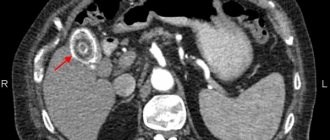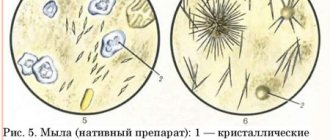The entire length of the gastrointestinal tract is lined with mucous membrane, which plays a role in the digestion and absorption of various substances. This structure is very vulnerable and requires certain protection to maintain its integrity and normal functioning.
For this purpose, the gastric mucosa is endowed with accessory and mucosal cells, and goblet cells work similarly in the intestine. These cells secrete mucus, which envelops the mucous membrane, protecting it from acids, alkalis, and mechanical injuries from coarse food particles.
Generally accepted norm
Mucus in the stool of a baby.
Komarovsky advises Changing the stool of babies begins from their very birth. First, meconium must come out, and then potassium masses acquire other indicators related to the type of food (breast milk or formula).
With the introduction of complementary foods, the consistency, color and smell change again. While the baby is getting used to the new food, says Evgeny Komarovsky, the baby may have remnants of undigested food, mucus, bloody streaks, etc. in the feces. It is also important to monitor the child’s condition. If he is active, has a good appetite, sleeps soundly, feels great - a change in stool does not mean any illness. Their main reason is considered to be the adaptation of the digestive system to a new product . See your pediatrician to calm your nerves, and continue to grow up healthy.
What is normal stool in children under one year of age? Each baby has its own norm, the main thing here is comprehensive monitoring of him and his stool.
General characteristics of the physiological norm:
Color:
- all shades of yellow;
- orange;
- light brown;
- green (light, dark), if breast milk and complementary foods predominate in the diet;
- different color due to taking medications, vitamins (which one - check with the doctor who prescribed them).
Consistency:
- mushy;
- heterogeneous;
- soft, maybe liquid.
General characteristics of the physiological norm of feces in infants
Impurities:
- multiple curd lumps (white) - indicates overeating when digestion does not have time to process the amount of breast milk (formula);
- mucus in the stool of a baby - Komarovsky E.O. recommends paying attention to its volume, frequency, and general condition of the child (all children have it, and this is normal).
See a doctor immediately if your child has black stool. It is considered normal only due to the use of certain medications, for example, activated carbon. If the feces include black fragments, or are completely colored for no apparent reason, this is a sign of serious upper gastrointestinal bleeding .
Discolored (white) potassium masses are also not normal, but a sign of hepatitis .
Reasons for appearance
What is the reason for the appearance of excessive mucus in the stool? Leave the determination of the true reasons to the doctors.
And we will provide in a few words the possible options:
Inflammatory processes in the gastrointestinal tract due to:
- eating disorder;
- incorrect, not according to age, selected mixture, different food;
- putting the baby to the breast incorrectly;
- the mother’s diet is ill-considered relative to the child’s age;
- untimely start of complementary feeding;
- food, drug poisoning;
- disease, infection.
Some clots resemble fragments of dead worms. In any case, it is better to take a stool test for I/g several times in a row, and 1 scraping for enterobiasis.
If there are clots in the baby's stool that resemble fragments of dead worms, you will need to take a stool test for egg worms
Lactose deficiency has several categories, but mucus is always present among the symptoms.
A baby with a cold may swallow nasal discharge with a runny nose (acute stage of a respiratory disease ). It hardly changes after passing through the gastrointestinal tract and is released during bowel movements.
To ensure normal mucus in the feces of an infant, Komarovsky E. O. recommends introducing complementary foods in a timely and correct manner, cleaning the nose , and when prescribing antibiotics or other medications that completely kill the intestinal microflora, make sure that the doctor prescribes a medication to maintain the balance of beneficial bacteria during treatment. Otherwise, diarrhea and other complications are guaranteed.
Determining some causes by the color of mucus:
- colored pink – bleeding in the lower intestine ;
- black streaks or feces - bleeding in the upper gastrointestinal tract ;
- transparent clots, streaks - severe runny nose in a child, inflammation of the intestines, infection of viral origin ;
- white – pathologies, parasites, intestinal infections ;
- cloudy green, yellow + stench of stool - infection of bacterial origin .
Evgeny Komarovsky joins the opinion of his colleagues regarding the presence of excessive mucus in the stool in infants. It is not normal if the baby poops more than 8-10 times a day , his stool is too liquid (watery), has a pronounced color, a pungent or putrid odor, a lot of mucus or foam, and blood . Call an ambulance without waiting for fever and vomiting. These are all signs of infectious or other diseases. Even normal diarrhea can cause complications.
If the stool is “strange” relative to the norm, parents are advised to take a diaper stained with feces with them to the hospital so that the doctor can quickly determine the possible causes of the changes (there is nothing shameful in this, because the results of laboratory tests will not be immediately available, and lost time can cost the child’s life ).
ideales.ru
What could this mean?
In the presence of mechanical or chemical irritation, the process of mucus secretion is much more active than in the normal state. The same can be said about the development of inflammatory processes. If, under normal conditions, feces are completely mixed with mucus in the cavity of the baby’s colon, then the development of one or another pathology can provoke an increase in its amount. To determine the amount of mucus in the stool, a coprogram is performed.
A coprogram is a laboratory diagnostic study of the consistency, color and presence of various elements in the patient’s stool (leukocytes, red blood cells, mucus, fatty acids, starch, etc.). Based on the results of the coprogram, as a rule, one can judge the development of diseases of the gastrointestinal tract.
An excessive amount of mucus in the stool indicates that the baby’s body, or rather his intestines, is trying to protect himself in this way. The mucus may be clear, yellow, or green . First of all, it depends on the nature of the disease or damage. Transparent mucus indicates catarrhal inflammation, green or yellow mucus indicates the development of a purulent or bacterial process. There may also be blood in the stool. This phenomenon is usually associated with peptic ulcer disease or hemorrhagic inflammation (a serious pathological condition that is accompanied by the penetration of red blood cells into the site of inflammation).
Intestinal infections
A characteristic symptom of acute gastroenteritis is diarrhea. It is often accompanied by vomiting, high fever, and deterioration in general condition. Watery stools may contain mucus.
As a result of the development of pathogenic microflora, the mucous membrane becomes inflamed. The intestines try to protect themselves from pathogenic microorganisms by producing large amounts of secretion.
A child pooping mucus is a process of the immune system fighting an intestinal infection.
With an intestinal infection, the baby experiences a high temperature and mucus in the stool. The color of stool depends on the type of pathogen.
Yellow mucus in a child’s stool indicates the development of a bacterial process. Transparent occurs with physiological enterocolitis.
If infectious gastroenteritis is suspected, it is not recommended to feed the child dairy products.
When an infection enters the digestive tract, the production of the enzyme that breaks down milk sugar is reduced. And the accumulation of milk sugar in the intestines causes even more dilution of the stool.
Causes of mucus
Often the appearance of mucous discharge in children is associated with malnutrition, but this symptom can also indicate the development of various pathologies, some of which can pose a great danger to health. Below are the main factors that can cause mucous discharge.
Table. Signs indicating hidden threats to the baby.
| Cause | Description |
| Often, mucous discharge in children occurs due to infection with worms. As a rule, you can become infected with worms if you do not follow hygiene rules. Usually, various experiments with meat or fish conducted by parents lead to the appearance of worms. The disease is often accompanied by nausea, loss of appetite, fever, sudden weight loss and other clinical signs. | |
| In rare cases, heredity is involved in the development of inflammatory processes in the intestines. The appearance of inflammation is accompanied by increased gas formation, colic in the intestines, ulcerative colitis, the appearance of mucus in the stool, constipation or diarrhea. | |
| Intoxication occurs, as a rule, when consuming low-quality or expired products. Infection of the patient's intestines with pathogens leads to loss of consciousness, fever, vomiting and diarrhea. | |
| The penetration of pathogenic microorganisms or bacteria into the intestinal cavity leads to the development of an inflammatory process. As a rule, infection with one or another type of infection is associated with non-compliance with personal hygiene rules, which results in the development of dysentery, enteritis, salmonellosis and other pathologies. | |
| A common phenomenon manifested as an imbalance between pathogenic and beneficial microflora in the human intestine. The most common cause of microflora disturbance is long-term use of antibacterial drugs or poor nutrition. Associated symptoms include decreased immunity, colic, bloating, etc. | |
| Some intestinal pathologies can also cause mucus to appear in the stool. For example, if bloody mucus is noticed in a child, this may indicate volvulus or intussusception (a pathological process in which one part of the patient's intestine invades another). Symptoms of diseases of the digestive system include: pain, general weakness of the body, fever, and bouts of vomiting. |
On a note! At the first appearance of impurities in a child’s stool, including mucus, you should immediately consult a doctor for laboratory analysis. As a rule, the cause of the appearance of white mucus is dysbiosis, although there may be other causative factors. This will all be shown by the results of the tests performed.
The doctor may also prescribe an analysis for the presence of parasites if, along with the appearance of mucus, the child’s appetite has worsened, weight has decreased, fatigue and lethargy have appeared. A timely visit to a doctor will not only identify a possible disease at an early stage of development, which will significantly speed up the treatment process, but also prevent the development of many other health problems. The main thing is not to delay visiting a doctor, because your child’s health is at stake.
Does mucus always indicate danger?
Stool with mucus in a child often causes anxiety among parents. At the same time, the thought immediately comes to mind that the baby has health problems. Why do children’s stools actually contain mucous inclusions and what should parents do in this case?
Mucus is one of the natural human secretions. Produced by special cells of the gastrointestinal mucosa, it allows you to perform many useful functions. For example, in a child with mucus, the remains of undigested food move more easily. Often it is completely mixed with feces. It is not always possible to accurately determine it visually. For this purpose, there are special laboratory tests in medicine.
Sometimes parents may notice small amounts of mucus in their child's stool. In such a situation, you need to pay attention to the condition of the baby. If he feels well, and the stool has a regular consistency and without foreign inclusions, then there is no need to sound the alarm. In many ways, the appearance of mucous discharge during bowel movements is explained by the characteristics of the child’s body. For example, in a child under 5 months, according to most experts, stool normally has the right to be of any color with mucus and of any consistency.
However, if mucus in the stool is accompanied by fever or defecation problems (diarrhea or constipation), parents should sound the alarm in time. This clinical picture, as well as a large amount of mucus, indicates pathological processes in the body.
In what cases is a doctor needed?
In most cases, mucus in a child’s stool goes away on its own after some time, but sometimes it is impossible to do without medical help. When to call an ambulance:
- frequent urination, in which the baby has an unpleasant smell of urine;
- an unpleasant putrid odor appeared from the mouth;
- there are problems with weight gain, that is, the child gains no more than 125 g per month;
- duration of frequent and loose stools for more than 10 days;
- blood appeared in the stool;
- body temperature increased;
- The baby has severe bouts of vomiting.
If at least one of the above symptoms appears, you should immediately call a doctor. Otherwise, the likelihood of developing serious complications increases, which will significantly slow down the treatment process.
Functions of mucus in the body
Parents' anxiety when mucus is found in their child's stool is not hyperbolization, but natural concern for their child.
Responsible parents pay attention to all the processes occurring with their baby and will wonder why the child has mucus in his stool, because the well-coordinated functioning of all systems and organs depends on the state of the baby’s digestion.
A baby’s stool is the litmus test that alerts you to problems or threats to the health of both the baby and older children.
Mucus in the child's stool was observed by the parents at least once.
This is how the intestines protect themselves from alkali and acids. Mixing with feces occurs in the rectum, and at the exit the impurity is almost invisible.
In normal quantities, without accompanying additional signs of disease, this is a normal phenomenon.
If the required amount of such intestinal protection is missing, the baby faces constipation. Abundant such impurities in the stool require that the cause of such processes be discovered and eliminated.
Features of treatment
After the examination, the doctor can make an accurate diagnosis, on the basis of which a course of treatment is selected. Diagnostic methods include scatology, urine and blood tests, examination of intestinal microflora, laboratory analysis of stool for carbohydrates and eggworms. If mucus impurities appear due to an unbalanced diet, then there is no need to take medications. In such cases, the doctor makes some adjustments to the diet and diet.
Detection of dysbiosis in a baby is also a reason to change the daily diet. In this case, the best treatment is breastfeeding. In rare cases, the doctor may prescribe medicinal formulas if breastfeeding the child is not possible. Therapy consists of taking antibiotics, and then probiotic drugs (“Bifiform”, “Bifidumbacterin” and “Linex”).
On a note! Taking certain potent drugs can often lead to the appearance of mucous stool. In this case, the problem can be eliminated by stopping the medication.
In the treatment of intestinal pathologies of an infectious nature, antibacterial drugs are used, including Furazolidone, Enterofuril and Cephalosporin. It must be remembered that prolonged diarrhea in combination with vomiting leads to dehydration. Therefore, hospitalization of the baby is necessary to avoid serious consequences. When infected with parasites, the course of therapy may vary depending on the type of helminth. For example, when amoebiasis is detected, Metronidazole or Tinidazole is used.
In rare cases, doctors resort to surgery . As a rule, surgery is necessary when drug treatment is ineffective or in case of acute intestinal obstruction. Failure to provide surgical care in a timely manner can lead to death - the child will die from sepsis, dehydration or painful shock.
To alleviate the baby’s condition and prevent dehydration due to diarrhea, the doctor can make small adjustments to the nursing mother’s menu. First of all, all harmful foods (flour, fried, sweet and salty foods) are excluded from the diet. At the same time, it is recommended to eat those foods that will prevent dehydration, but will not cause any harm to the baby’s health. We are talking about jelly, crackers, bananas, rice, oatmeal, etc. Doctors also prescribe plenty of drinks for babies, including baby tea and clean water.
If a child does not want to drink water or tea prescribed by doctors, then special solutions are administered intravenously. In parallel with this, drugs are prescribed to cleanse the body (sorbents), the most common of which is Smecta.
Useful tips
There are several preventive measures to prevent the appearance of mucus in the stool and other problems with the baby’s stool:
- timely treatment of diseases, especially congenital ones;
- If mucus appears in the stool, consult a doctor immediately;
- observing the rules of personal hygiene and teaching the child to hygiene from an early age;
- periodic laboratory tests for the presence of parasites;
- compliance with the baby's diet. Make sure his diet contains enough fiber. Otherwise, constipation may occur;
- Complementary foods should be introduced correctly, that is, in a timely manner and gradually. If you ignore these rules, you may get intestinal irritation;
- Formulas for artificial feeding must be selected carefully. Therefore, if you are in doubt about this, it is better to seek help from a specialist;
- When breastfeeding, a nursing mother must monitor her diet, while refusing junk food.
Following these simple recommendations will help ensure the normal functioning of the gastrointestinal tract, which will avoid many health problems in the future. After all, everyone knows that a predisposition to a particular disease can be established in the body from the first years of life .
stomach-info.ru
What can parents do?
Perhaps mucous discharge in the baby’s stool is a temporary one-time phenomenon, and there is no need to worry. But if you see that your child is constantly releasing mucous lumps, diarrhea has begun, the stool has an unpleasant odor, the child is crying, sleeps restlessly or is not gaining weight well, you should contact a specialist. Perhaps the pediatrician will prescribe tests, for example, examining stool for dysbiosis, and then, depending on the diagnosis, recommend treatment.
If there are any changes in the child’s stool, and even more so if mucus appears in the stool, causing suspicion of pathology, it is necessary to consult a pediatrician. A qualified professional will be able to determine whether dietary changes, active intervention, or more thorough evaluation are needed.
Source: care-children.ru
Normal or deviation
In the first months of life, the baby’s stomach and intestines work in test mode, and therefore require special attention. But pediatricians warn about the acceptable amount of mucus in the stool of an absolutely healthy baby up to three months of age. Let's try to figure out how to recognize the norm and not miss the pathology.
What is meconium
Newborns' first feces are called meconium. It contains epithelial cells and hairs processed in the prenatal period, as well as water, bile, mucus, amniotic fluid and bacteria. According to Spanish researchers, among them are lactobacilli and E. coli. This means that even in the womb, protective functions are formed in a small organism. Meconium is excreted from the baby's intestines during the first days of life. Its characteristic features are the absence of odor, dark color, viscous and sticky consistency.
Norms of mucus in feces
Subsequently, the child poops jelly-like or watery yellow discharge with a small amount of mucus. This is not at all a symptom of any disease and should not cause panic among parents. The baby's intestines thus protect themselves from aggressive acids and alkalis that form in the digestive organs during the processing of breast milk. However, mucous secretions mix with feces in the large intestine, so they are practically not visible at the exit. You should be wary when you often notice individual mucous fragments in children's feces. If they appear rarely, then there is no reason to panic. You need to sound the alarm when your baby's stool has an unpleasant, pungent odor and contains blood. At the same time, the baby sleeps poorly, is restless, often burps, and does not gain weight.
Normal stool in a child
The digestive system of a newborn is sterile. During the first feeding (breast milk), the intestines are filled with a variety of microorganisms. They can be beneficial (bifidobacteria and lactobacilli) and harmful (pathogenic).
Often young parents get scared: the child is one month old, and mucus appears in the child’s stool. You need to understand what bowel movements are considered normal at this age and what are the causes of mucus in a child’s stool.
Baby feces in the first 3 days of life are called meconium. It is a black-green mass that resembles tar.
In the first 3 days of a newborn’s life, meconium is considered normal - a black-green mass (like tar) without odor. On the 3-4th day, feces are called physiological dyspepsia, they consist of lumps and yellow-green liquid.
Starting from the 5th day of life, stool becomes normal and varies depending on nutrition - artificial or breastfeeding.
Mucus is a mixture of leukocytes and epithelial cells. It is needed to protect the walls of the stomach and intestines from the negative effects of food and vital activity. But if a child has a lot of mucus in his stool, this indicates an inflammatory process.
If the baby is breastfed (naturally) fed, the stool is mushy, yellow or slightly greenish in color with a sour smell. The frequency of bowel movements is equal to the frequency of feeding. When bottle-fed, feces are thicker, brown in color (with various shades) and have a pungent odor. The baby defecates once a day.
We suggest you read Prevention of worms in children, what to give a child to prevent worms for a child under 2 years old
As a rule, in the 1st month, beneficial and harmful bacteria fight for “leadership”, and by the end of the 1st month of life, only bifidobacteria and lactobacilli should remain. During this period, green mucus in a child’s stool is not considered a pathology. Moreover, the green color of the poop is normal due to the consumption of breast milk. In this case, the baby should be active, feel good, and should not have diarrhea. Weight is gaining.
Yellow (brown) color is also considered the norm for artificial babies. When switching to a mixture from another manufacturer, the shade may change. The presence of a small amount of yellow mucus in the stool should not be alarming if the baby feels well, is active, and is gaining weight. Otherwise, you need to urgently visit a pediatrician.
Reasons for appearance
Excessive amounts of feces and mucus in a newborn baby can be due to various reasons:
- Dysbacteriosis and dehydration of the body.
- Unsterility of breast milk (in this case, the mother needs to have it analyzed).
- The presence of allergenic foods in the mother’s diet (citrus fruits, bananas, berries, some vegetables, and dairy products can cause an allergic reaction).
- Incorrect introduction of complementary foods, when new foods are introduced into the baby’s diet too early, or heavy and poorly digestible purees are offered to him.
- A large gap between the baby's breastfeeding.
- Inflammation in the baby’s intestines, which may well be caused by some viruses.
- Partial intestinal obstruction, formed as a result of pressing one intestine onto another.
- Celiac disease (occurs when the body does not produce the enzymes necessary for processing and assimilating food).
- Bronchitis and runny nose (mucus can enter the digestive tract through swallowing phlegm and snot).
- Side effects of taking “Espumizan”, “Bobotik”, “Bebikalm” (especially if the baby is often given such drugs).
- Infectious diseases caused by staphylococcus, enterocolitis, salmonellosis, dysentery (in such cases, mucous bowel movements are accompanied by sharp pain in the abdomen and diarrhea).
- Polyps, hemorrhoids (then the mucus does not mix with the feces, enveloping them).
- Cystic fibrosis. This is a congenital disease in which the child has a cough with sputum, excessive drooling and sweating.
- Helminthiasis.
Types and characteristics
A particular danger is whitish and liquid mucous stool in infants. Often you can notice blood impurities and fat in it. The child in such situations is very restless, he suffers from colic, and the temperature may rise. Let's take a closer look at when to sound the alarm and what the color of children's stool means.
Transparent
According to experts, small amounts of transparent mucous masses indicate inflammatory processes in the respiratory tract. They can also be triggered by enteroviruses that attack the walls of the large and small intestines.
White
Foamy or thread-like whitish discharge may appear in different cases. Most likely, the baby has pathologies in the digestive tract that require immediate examination by specialists. We are talking about the causative agents of dysentery and salmonellosis. It may also be an expression of the vital activity of helminths. If white thread-like mucus comes out with hard feces, and the baby often suffers from constipation, this may be a sign of polyps formed in the intestines. In any case, when white mucus appears in the stool, it is important to conduct a timely examination and begin treatment.
Green
Mucus of all shades of green is a clear sign of dysfunction of the digestive organs due to the activity of bacteria. Often these stools contain particles of blood and undigested food. You should seek medical help immediately, since an intestinal infection is raging in the baby’s body.
Yellow
Regular yellow lumps of mucus in liquid baby stool also indicate intestinal dysfunction. If these discharges have an unpleasant, pungent odor, then the reason for their appearance may lie in an insufficient amount of enzymes, the presence of an intestinal infection or helminths. In all cases, you should not delay your visit to the doctor.
Pink
This color of mucus is a clear sign of serious problems in the baby’s intestines. It appears as a result of blood impurities caused by a hemorrhagic inflammatory process on the mucous membranes of the gastrointestinal tract.
Possible reasons
Quite often this phenomenon is observed in children in the first days or weeks of life. Mucous stool in a newborn is explained by the fact that the baby has a sterile gastrointestinal tract. Along with food, various bacteria penetrate into it - both beneficial and pathogenic. A struggle for survival begins between them.
- violation of the diet by a nursing mother;
- unsterile breast milk;
- intestinal dysbiosis caused by pathogens;
- lactose intolerance;
- switching to another type of formula when artificial feeding;
- thrush transmitted by the mother during childbirth;
- introducing complementary foods too early.
In older children, the most common reason for the appearance of a lump of mucus (or several) is dysbacteriosis. This is especially true if we are talking about a one-year-old baby who puts everything in his mouth and can easily catch an infection. Of course, for this reason, mucus may appear in the stool in a child of 2 years of age, as well as in older children.
Other common reasons include:
- an unbalanced diet or a sudden change in it;
- colds, acute respiratory infections, ARVI;
- taking antibiotics;
- hypothermia in the pelvic area (bathing in a pond for a long time or sitting on damp ground);
- worms;
- prolonged constipation;
- allergic reaction.
Much less common in children are such provoking factors for the appearance of lumps of mucus in the stool, such as autoimmune pathologies, cancer, Crohn's disease, intestinal obstruction, cystic fibrosis, colitis. All of these ailments are very serious. During the examination, they should be excluded first.
Normal stool in a baby
Diarrhea with mucus in an infant
In the summer season, when there is an abundance of fruits and vegetables, newborns often receive dangerous microorganisms that cause intestinal infections, as well as Giardia, from their mother’s milk. Then the baby is tormented by sharp pains in the tummy, he bends his legs, constantly cries and often defecates with watery discharge with mucus. In cold seasons, a similar picture is caused by entero- and rotaviruses. Diarrhea with mucus in infants is a dangerous phenomenon because it threatens complete dehydration of the body. During the period of infection, the intestines intensively try to free themselves from all contents, thus removing water and salts. According to experts, non-infectious diseases can also provoke diarrhea in a newborn: gastroenteritis, enterocolitis, lactose deficiency, overeating, milk intolerance, emotional distress, stress. The cause of diarrhea can be determined after conducting the necessary studies of the baby’s stool. It is important for mom to pay attention to their color, frequency and consistency. Treatment will be prescribed depending on the diagnosis. This could be a special diet or drug therapy.
What to do
When a child poops with diarrhea, regardless of its color, it is important to eliminate the cause of the pathology. First of all, you need to rinse your stomach with chamomile decoction and take some kind of adsorbent. Most often, solutions of “Regidron” or “Oralit” are prepared. Such powders should always be in your home pharmacy. It is also important to review your diet while breastfeeding and the components of baby food. The daily menu should not contain heavy, difficult to digest food or allergy-causing foods.
Be sure to exclude carbonated drinks, sweets, smoked foods, fatty, salty, spicy, dairy and fiber-rich foods from the list of permitted foods. Preference should be given to crackers, herbal teas, rice water, bananas and boiled potatoes. They can also be given to older children. During this period, drinking plenty of fluids is very important for him. It is best to give dill water and chamomile tea.
If the baby has a fever, he needs to be given an antipyretic drug (Panadol). When symptoms of body poisoning appear, it is important to help the small body cope with toxins. To remove them, it is recommended to give the baby Enterosgel. Having noticed that the child is suffering from painful convulsive attacks in the intestinal area, you can alleviate his condition with “No-shpa”. Other medications should not be given to a child without consulting a pediatrician, because illiterate treatment can only worsen the disease. If there is no relief, immediately call an ambulance and conduct a comprehensive examination of the baby.
Reasons for calling an ambulance
Often, mothers, when they see their baby’s liquid feces, begin to worry. There is no reason for this if foamy discharge appears periodically, there are no blood spots, orange and green flakes in it, and the mucus comes out transparent and in small quantities.
These “abnormalities” can be eliminated using the above methods at home. But if a child has a very frequent urge to defecate (up to 20 times a day), and the discharge has a liquid consistency and is characterized by a fetid odor, green or white color, blood impurities, brown-green mucus, you need to sound the alarm. Very often, the listed signs of illness for a son or daughter are accompanied by fever and vomiting. An exhausted child looks pale, feels lethargic and constantly wants to sleep. In this case, you should immediately call a doctor. Otherwise, the baby may suffer from dehydration. In addition, this process occurs very quickly, since when it is hot, the baby refuses to drink, and his body becomes very sensitive to water balance.
Mucus in stool: opinion of Dr. Komarovsky
The release of mucus into a child’s feces, according to Dr. Komarovsky, is the body’s natural response to new complementary foods. Moreover, a specialist respected by many mothers does not advise closely monitoring changes in the color, smell and consistency of baby poop. He believes that the baby’s digestive organs are just getting started, so they are trying to adapt the entire body to their needs. As a result, certain symptoms arise.
In any suspicious case, Dr. Komarovsky advises:
- Do not panic.
- Observe the baby for several days.
- If only the composition of the infant's stool has changed, nothing can be done. After the period of transferring the baby to “adult” food has passed, his gastrointestinal tract will work on its own.
- When the baby is not yet old enough and is breastfed, it is necessary to adjust the mother’s diet.
- Call an ambulance immediately if you have liquid, foamy, green diarrhea with blood clots.
No matter how hard mothers try to prevent these unpleasant moments for themselves and their baby, sooner or later they can happen in every family. Therefore, parents need to know what indicates a danger to the child’s health and how to act correctly in such situations. Don't forget these tips and keep a close eye on your baby's health.
agu.life
White mucus in baby's stool
This mucus looks like large veins or lumps . It may occur for reasons:
After 3 months, the frequency of bowel movements, their volume, and appearance change: this is due to a change in diet . The first complementary foods are added to the “artificial” menu, and children who are breastfed receive new combinations of nutrients along with their mother’s milk.
And the stomach and intestines have already learned to work together, harmoniously: the child is much less likely to be bothered by colic.
Lack of appetite, mucus in the stool, diarrhea may indicate that the stomach has not “accepted” a new, unusual product .
This condition, as a rule, does not require treatment and goes away on its own, as soon as the intestines are cleared of the “indigestible” dish.
But if there is usually a lot of mucus and food particles in the feces, they have changed color or smell, and the child has become worse at gaining weight, perhaps the baby suffers from a lack of enzymes and “correct” microorganisms that facilitate digestion and absorption.
To confirm (or refute) the diagnosis of lactose intolerance , you need to take tests for carbohydrates and weigh the baby daily.
Why does mucus appear in stool?
Mucus is a viscous substance produced by the cells of the epithelial tissue of the mucous membranes. Antiseptics and immunoglobulins contained in mucus perform a protective function in the hollow organs of the gastrointestinal tract. Mucus helps in moving food, protects mucous membranes from bile, acid, and alkali.
The appearance of inflammation and pathogenic microbes in the body causes cells to produce secretions in large quantities in order to resist the disease.
Doctor Komarovsky about intestinal infections, video:
Mucus in the stool of a newborn baby
If a newborn baby poops mucus, then the nursing mother should reconsider her diet; it is possible that forbidden foods were consumed while breastfeeding: high-calorie, fatty, spicy foods. If a nursing mother, without violating the rules, eats correctly, it is advisable to check the sterility of breast milk.
For artificially-bred babies, a milk formula that is maximally adapted to the composition of natural nutrition is selected, feeding utensils are properly sterilized and boiled.
An allergic reaction to lactose can also cause the appearance of mucus in a child’s stool; in this case, a “lactose-free” formula is selected for the children, and the nursing mother switches to a dairy-free diet.
Starting from 6-7 months, the child is introduced to the first complementary foods in the form of vegetable and fruit purees, so the intestinal reaction in the form of feces with mucus should not frighten the parents; over time, the child’s stomach will get used to the new food.
Stool with mucus in a one-year-old child
Often the cause of mucus in the stool of a 12-month-old baby and older is a runny nose and cold.
The baby cannot blow his nose on his own; mucus from the nasal passages and sputum from coughing enters the stomach and comes out undigested along with the feces. Children from 1 to 3 years of age are at risk of contracting helminthic infestations, as evidenced by white mucus coming out with excrement. Children of this age often put dirty hands and toys into their mouths, thereby infecting the body with parasites.
Problem for older children
The reasons for the mucus that appears in the feces of older children (3-4 years old) are easier to identify; the baby can already complain, describe what and how it hurts.
A small number of beneficial bacteria in the body reduces immunity, and the child is often exposed to colds and infectious diseases. A symptom of dysbacteriosis can be diarrhea with mucus, accompanied by sharp, stabbing pain in the abdomen, which passes after relief. The need to go big appears a short time after eating.
The main causes of dysbiosis:
According to the well-known and beloved pediatrician E.O. Komarovsky, dysbiosis is not a disease, much less a sentence, it is a term characterizing the state of the intestinal microflora. Dysbacteriosis is a consequence of a disease, which means it is advisable to treat exactly the cause that caused the appearance of such a disorder.
Pathologies accompanied by the appearance of mucus in the stool
The presence of a small amount of mucus in the stool of a child who is feeling well should not worry parents. It’s another matter when there is a lot of it and the appearance is accompanied by the following symptoms: fever, nausea and vomiting, loose stools with an odor not characteristic of normal feces, cutting, stabbing pain in the abdomen. You shouldn’t hesitate here, you need to seek help, since the combination of these symptoms may be a sign of gastrointestinal diseases, including:
- Food poisoning, drug poisoning - ingestion of poisons and toxins disrupts the vital functions of the body.
The first symptoms of food poisoning are nausea, vomiting, dizziness, diarrhea with mucus, and abdominal pain. While waiting for the ambulance to be called, provide the child with plenty of fluids, give activated charcoal, and induce vomiting if there is none.
- Infection with parasites - ascariasis, giardiasis, simply worms - is a consequence of unwashed hands, vegetables, and fruits.
Children of all ages are susceptible to the disease.
- Infectious bowel diseases - the main reason is non-compliance with hygiene standards and rules.
The causative agents of intestinal infections are: salmonella, staphylococcus, dysentery bacillus, and some viruses. Bacteria can affect individual organs of the gastrointestinal tract, causing the following diseases to be treated: gastritis, colitis, enteritis, etc. Seek help immediately if the body temperature rises, incessant vomiting, absence of urine for more than 5 hours, if the child goes to the toilet loosely and is present in the stool blood, pink mucus.
Inflammation of the intestinal mucosa during enteritis
- Surgical diseases - intestinal obstruction (volvulus, intussusception), diverticula, requiring surgical intervention in complicated cases.
They are manifested by severe bloating, vomiting, sharp pain in the abdomen, and a small amount of feces mixed with mucus and blood.
When to see a doctor
Mothers need to carefully monitor their baby's bowel movements. This is especially true for young children who cannot clearly describe their symptoms.
If the child’s general well-being is normal and there are no additional complaints, you can watch the baby a little, change the nature of your diet, or, if you are breastfeeding, go on a strict diet yourself. If the baby’s stool does not change within a few days, you can routinely consult with a pediatrician and, if necessary, have a culture tested for dysbacteriosis or coprogram.
We recommend reading:
Norovirus: how is the infection transmitted, manifested and treated?
You should definitely consult a doctor if:
- increased body temperature;
- nausea;
- vomiting;
- the appearance of pathological impurities (blood, helminths, pieces of undigested food);
- flatulence;
- change the colors of the slime to green, white or red;
- stomach ache;
- pronounced anxiety of the baby, crying;
- severe diarrhea.
You should consult a doctor if:
- mucus is green and smells unpleasant;
- appetite decreases, baby does not gain weight;
- vomiting occurs (follow this link to learn how to stop your child from vomiting);
- the baby's urine smells unpleasant;
- the temperature rises.
If the baby is less than a year old, it is better not to self-medicate and not to put off visiting a doctor until later. It is better to immediately contact a specialist or call an ambulance.
Treatment
Before treating the occurrence of mucus in the stool, you need to find the true cause of this phenomenon. A specialist can make a diagnosis and prescribe the correct treatment based on the accompanying symptoms. The doctor will tell you which test to take (general stool test, test for enterobiasis, dysbacteriosis) and how to treat a child of a given age.
Do not self-medicate; taking even a harmless drug should be discussed with your pediatrician over the phone. Do not take medications for preventive purposes.
The best prevention of intestinal diseases will be a balanced diet with high-quality products and adherence to personal hygiene rules.
Doctor Komarovsky about dysbiosis, video:
www.lechimzapor.com
Diagnostic methods
Abundant mucus in the stool is clearly visible to the naked eye. It is also easy to notice bloody, yellow, green, white, black masses. Before going to the doctor, it is advisable to take a closer look at the clot of mucus, determine its consistency, shade, and quantity, so that the specialist gets the most complete picture and chooses the optimal examination methods. You can take your baby's soiled diaper with you.
Stool analysis - a coprogram for diagnosing the disease
Most often, if there is mucus in the stool, a coprogram is performed. Also practiced are bacterial culture, macro- and microscopy of feces, a general blood test, studies to identify parasites, ultrasound, and x-rays. The use of certain methods depends on the symptomatic picture, medical history, age, and general condition of the patient.
It is necessary to differentiate physiological manifestations of mucus from pathological ones. The main hint about the origin of the symptom is additional clinical manifestations and a thorough questioning of the mother (what the child ate, whether he was sick with anything recently, whether new complementary foods were introduced, whether there are hereditary diseases).
Basic tests that may be needed to identify the underlying cause:
- Coprogram. Microscopic and biochemical examination of feces will determine additional pathological signs: undigested food, the presence of hidden blood, worm eggs.
- Bacteriological culture (tank culture). Allows you to determine the presence of the pathogen and its sensitivity to antibacterial therapy.
- Culture for dysbiosis. Reveals the degree of separation of pathological and beneficial microflora.
- X-ray of the abdominal organs. Allows you to determine intestinal obstruction, an important test in infants with signs of abdominal bloating against the background of continuous crying (intussusception).
- Blood tests. Even a clinical analysis will make it possible to determine the nature of the inflammation (bacterial - with neutrophilic leukocytosis, viral - with lymphocytic leukocytosis, eosinophilia - with an autoimmune process or helminthic infestations). Blood tests are also carried out to check for antibodies and increased levels of autoimmune factors.
We suggest you read: Meningococcal infection in children, symptoms, treatment methods









